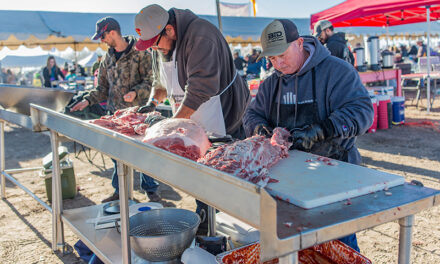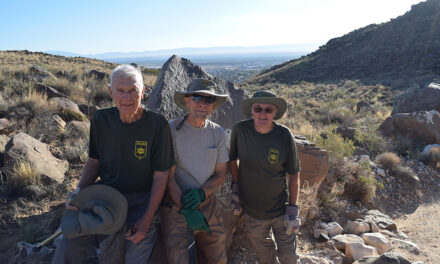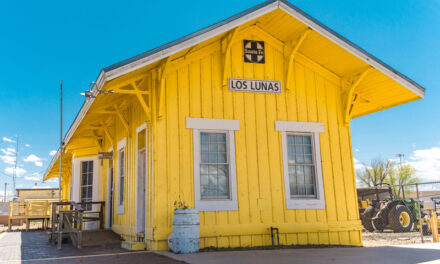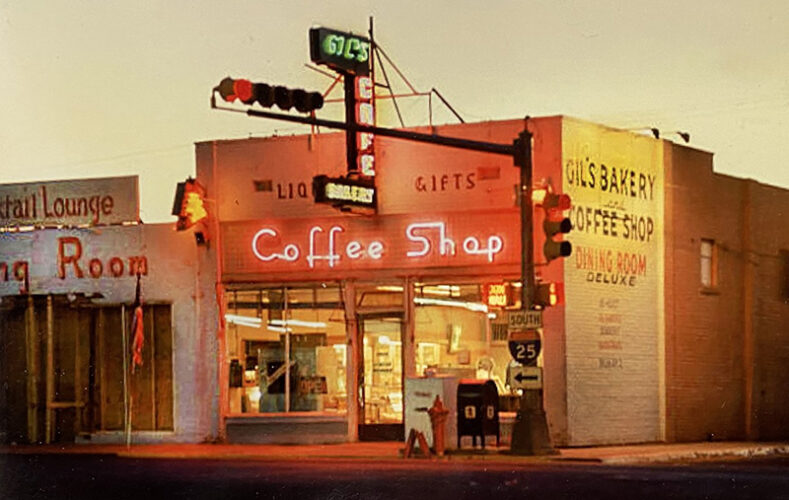
Photo courtesy of LeRoy N. Sanchez
It was one of the largest grand openings in Valencia County history. Announced in a quarter-page ad in the Belen News, Gil’s Coffee Shop and Bakery opened with great fanfare on Monday, April 14, 1947.
Hundreds of customers swarmed to the southwest corner of Reinken Avenue and North Main Street to take a look at the new place and enjoy as much free coffee as they could drink.
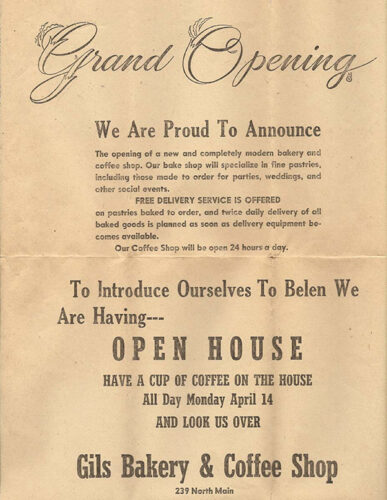
By the end of its first day, owner Gil Sanchez and his staff of six had served gallons of coffee and no less than 9,000 doughnuts. Gil told a local reporter that he and his crew had no rest and were completely exhausted by day’s end.
Little did Gil know that this was just the beginning of many years of hard work and service — 40 years, to be exact. But Gil Sanchez was the perfect person for this work and service at this time and place in Belen history.
Training
Gilberto “Gil” or “Gillie” Sanchez was born in Jarales on Sept. 20, 1916, the fifth of six boys and four girls born to Nestor and Carlota Sanchez. Gil learned his strong work ethic at an early age, first on his father’s farm and then during high school when he worked at Harrell’s bakery, located at the corner of South Sixth Street and Becker Avenue.
Gil always said that he grew up in Harrell’s bakery and that Harrell was like a second father to him.
“He was an all-German baker,” said Gil, at a time when “German baking was the best in the world.”
Harrell (nobody remembers his first name) was a “strict man, but a good man” and an excellent teacher. The German taught Gil how to make everything from scratch, from preparing the dough, to rolling it, to baking it and decorating the finished product.
From 1931, when he was a sophomore in high school, to 1935, when he graduated, Gil worked at Harrell’s from 4 a.m. to 8 a.m., before he went to class, and from 3 p.m. to 7 p.m. after school was dismissed.
With full days on Saturdays and Sundays, Gil worked 56 hours a week with few days off. He continued to work for Harrell until 1942, completing his “apprenticeship” and becoming an accomplished baker.
Gil also learned about security. One youth, who shall go unnamed, recalls stealing eggs out of the back door of Harrell’s bakery in the 1930s. The guilty party remembers that when Gil finally caught him he insisted that the culprit put an egg in his back pocket. When the boy obeyed, Gil promptly smashed the pocketed egg with his hand. No supplies were reported missing thereafter.
During World War II, Gil moved to Hawthrone, Nev., to manage a huge bakery that provided bread for a nearby Army base. There was so much work to do that Gil’s brother, Ted, joined Gil in Nevada, and Gil taught his sibling the baker’s trade.
Meanwhile, Gil had met and married Priscilla Ursula Sanchez in February 1941, a year after her graduation from Belen High School. The couple had three children — Raymond, Regina and Gloria — during the war years in Nevada. Their last child, Michael, was born in 1950.
The growing family returned to Belen in 1947 when Gil hoped to work for Harrell again. Finding no work available at his old bakery, Gil decided to strike out on his own.
Getting started
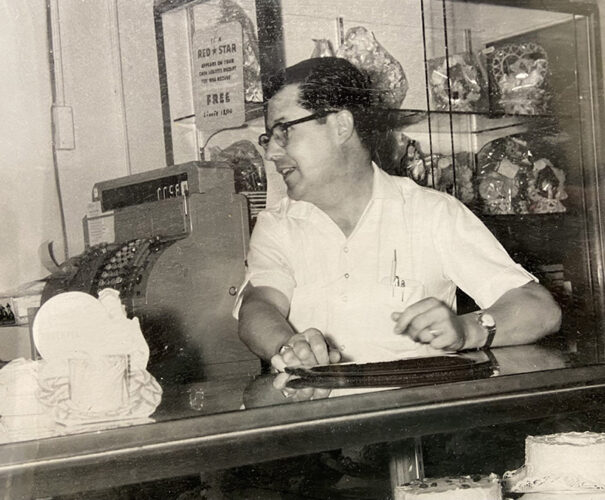
Gillie Sanchez, owner of Gil’s Bakery in Belen.
Gil planned to open his own bakery with two of his brothers as partners. Ted would help as a baker and Aurelio (Eddie) would drive the delivery truck, bringing fresh baked goods to grocery stores up and down the valley.
Gil applied for a $300 loan to rent space for his new business and buy some equipment, but the First National Bank of Belen turned him down, an affront he never forgot.
Fortunately, Joe Tabet recognized the venture’s potential and lent Gil the cash he needed to get started.
Starting as Gil’s Bakery and Coffee Shop in 1947, the business was so successful that it began serving meals and became Gil’s Bakery and Café in 1952. The enterprise expanded into the space next door in the Henry Sachs building and became Gil’s Bakery and Restaurant in 1961.
Adding a bar, which remained open from 1962 to 1978, the large addition was made available for gala parties, wedding receptions “and other social events,” according to advertisements.
Gil became the bakery’s sole proprietor a year after the business opened. He bought the property at 239 N. Main St. in 1978.
Successful early years
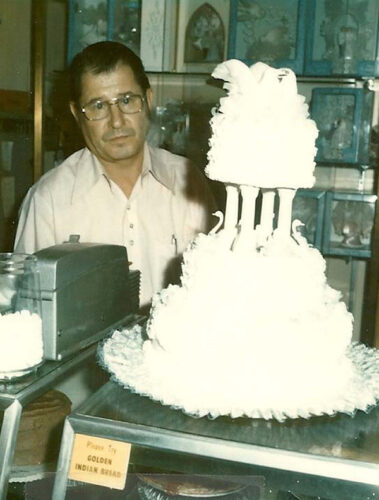
Gillie Sanchez enjoyed part of his work, but took great pride in cake baking and decorating.
The bakery was a huge success because Gil was a self-proclaimed perfectionist who demanded hard work from himself and everyone he hired. He kept a spotless operation and closed one day a week (Monday) not to rest but to clean.
Gil’s was best known for its excellent baked goods and meals. A breakfast menu from the 1950s listed doughnuts (10¢), sweet rolls (15¢), coffee (bottomless cup, 10¢), hot cakes (three for 50¢), huevos rancheros ($1.10), bacon and eggs ($1.25) and steak and eggs ($1.50). Glazed doughnuts, French bread, potato bread and long johns were popular as well.
Gil enjoyed every part of his work, but took great pride in cake baking and decorating. In perhaps his largest cake, Gil and his brother, Ted, took two weeks to make an anniversary cake for the Becker-Dalies Store. The cake was so big that it had to be moved on a gurney, and Gil had to remove the bakery’s back door to get it out.
Gil especially liked to save silver dollars, shine them and use them to help decorate cakes for 25th wedding anniversaries.
A true craftsman, Gil could hold three or four eggs in one hand and crack them all at the same time. He never needed to weigh ingredients or refer to recipes. Gil’s pastry was so exceptional that customers swore they could tell when Gil or a relief baker had done the baking each day. Gil’s doughnuts always tasted much better.
Gil’s was soon famous throughout the valley, the state and as far west as California. When people mentioned Belen, they inevitably mentioned Gil’s Bakery. Travelers on old Route 85 (now N.M. 314), railroad workers and many celebrities, including boxer Sonny Liston and singer Glenn Campbell, frequented the restaurant, day and night.
Working at the bakery
Gil’s Bakery employed hundreds of workers, from part-time high school students to professional bakers. Some, like baker David Bibiano, worked for many years. Others lasted only days.
The Belen News often carried classified ads for help needed at the bakery. With few other employment opportunities in town, many teenagers, especially girls, answered Gil’s ads, often working at the first jobs in their lives.
If hired, workers soon learned that Gil was a taskmaster, much like Harrell had been in Gil’s teenage years. Everything had to be spotless. And everyone had to stay busy — all the time.
If someone did not measure up to Gil’s high standards, he would fire him or her on the spot and run another ad in the newspaper for a replacement. In his words, “I was very strict. They had to do as I told them or else.”
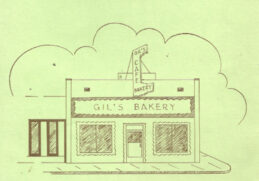
According to their daughter, Regina, the couple made a great team, both in marriage and in business.
As demanding as Gil and Priscilla were of their workers, they were kind and generous with those who worked hard and remained loyal over the years. Employees were paid average wages and often did well with good tips.
Workers could eat a hamburger and a 6 ounce Hub City soda each shift; later, employees could order anything on the menu for a quarter.
The couple always made sure that female workers had safe rides home if they worked nights. The Sanchezes also held employee gatherings, as on Jan. 4 to celebrate New Year’s Day in 1952.
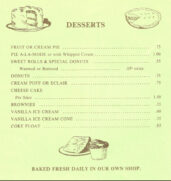
Inevitably, some employees made mistakes. Albert Gallegos worked at the bakery as a teenager years before he entered the priesthood. In a famous story, he accidently ruined the dough early one morning. Realizing his mistake, he threw the damaged dough in a trash can, hoping that Gil would never know what happened. Unfortunately, the dough rose in the trash can, revealing his “sin” and drawing Gil’s ire.
On another occasion, Gil’s son, Raymond, had accidentally confused whipped cream with lard on a Sunday morning. After his shift, Raymond had gone home, but was not there long when Gil called and told him that a lady customer complained that he had poisoned her. The woman survived, but Raymond, like Albert, was properly reprimanded.
But such incidents were rare, and, in most cases, served as learning experiences rather than disasters. For many local people, working at the bakery was a positive phase of their lives. Gil was especially proud that some of his young protégés went on to become fine bakers themselves, including Gilbert Cordova, who enjoyed a fine career as a baker in Denver.
Nearby businesses prospered from their proximity to the bakery and its steady flow of customers. Many men, for example, stopped by Louie Aragon’s barbershop next door after coffee at the bakery or en route to a social event at Gil’s. Louie, who took over the barbershop in 1966, says he could not have made it all those years without the business the bakery helped generate.
Of course, Louie was one of Gil’s regular customers. He even had a sign that he hung on his door during breaks each day: “At Gil’s.” Everyone who came by knew exactly what that meant and where to find him.
Social center
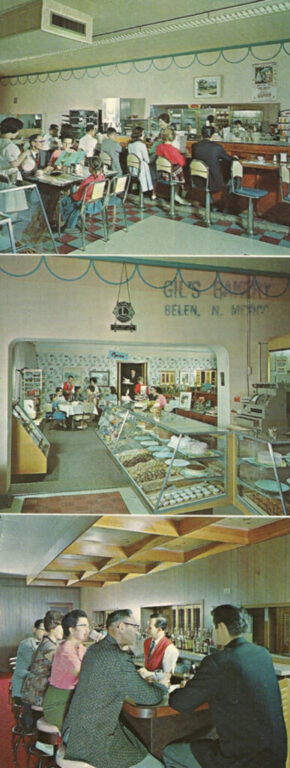
Everyone was welcome at the bakery. Gil’s son, Michael, recalls that Trini “Pito, Pito” Baca and Severito sat at special places at the counter, ordering the same meals every time they came by. According to Michael, Gil and Priscilla made sure that these two special Belenies always received the VIP treatment.
Families often celebrated special occasions at Gil’s. Countless wedding receptions, birthdays, graduations, reunions and wedding anniversaries were held, with elaborate cakes baked and decorated by Gil.
Clubs, including Rotary and the Optimists, held their weekly meetings at the restaurant. Families ate meals, especially after church on Sunday mornings when a waiting line often stretched out the front door. Families also congregated at the bakery after watching the county fair parade down Main Street or after big games at Belen High School.
Kids saved their hard-earned cash to buy doughnuts. Dan Chavez and his boyhood pals collected bottles to make money to buy candy at stores south of Gil’s. But they always saved enough to afford a doughnut each as their ultimate reward.
“Monday morning quarterbacks” frequented Gil’s to replay entire games after exciting high school basketball and football contests. Visiting teams often ate meals before or after games. As one newspaper reporter wrote, “People met there to eat, to talk and to have fun.” Many said the bakery was like a second home.
The bakery also supported social organizations and events in the community. It sponsored countless athletic teams and held an annual picnic at St. Mary’s playing field with games and a raffle for a coveted grand prize: a new Schwinn bike. The bakery sponsored floats in the county fair parade for many years, winning the prize for best float in 1949 and 1951. While other businesses and organizations threw candy to bystanders along the parade route, Gil’s employees and four children handed out doughnuts and cookies.
Priscilla often brought food from the bakery to senior centers, to those who were ill and to families that had suffered the loss of loved ones. Priscilla even brought doughnuts and whole meals to feed poll workers on Election Day until someone complained that this was an unfair, subtle way to influence the outcome of elections!
Politics
So many politicians gathered at Gil’s Bakery and so many political deals were made there that some called the bakery Belen’s second city hall. Leaders of both political parties dropped by, with the earliest arrivals claiming the coveted larger table.
There were few heated debates at a time when Democrats like Filo Sedillo and Republicans like Elfego Baca could congregate and share political gossip over a cup — or often many cups — of hot coffee.
State and national politicians knew that Gil’s was the political center of Belen. Sen. Dennis Chavez, Gov. Ed Mechem and Gov. Bruce King with his wife, Alice, were some of the many political leaders who made sure they dropped by when they were in town or just traveling through to somewhere else.
Sen. Birch Bayh, of Indiana, visited Gil and his bakery during John F. Kennedy’s presidential campaign in 1960. Three years later, many stunned residents of Belen gathered at Gil’s on the tragic day that the young president was assassinated in Dallas. Entering the political fray on his own, Gil served several terms on the Belen town council.
Gil’s two sons, Raymond and Michael, worked in the bakery and learned a lot about politics while watching their dad and other politicians in action. Both Raymond and Michael became lawyers and, remembering the lessons of their youth, rose to high levels of power in state government.
Raymond served in the state House of Representatives for 30 years, including 16 years of those years as speaker of the house. Michael served as our state senator from 1993 to 2016, rising to the position of majority leader in the New Mexico state senate.
One robbery
Remarkably, for all the years that Gil worked in the food service business, he experienced few attempted thefts and only one attempted armed robbery.
At about 5:15 p.m. on Tuesday, March 25, 1975, a 25-30-year-old man came to the bakery’s back door and asked to speak to Gil. He later recalled greeting a slim, fellow who stood about 5-foot, five-inches tall, wore jeans, a large black hat and a red T-shirt with the word “King” printed on it.
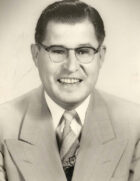
Gilberto “Gillie” Sanchez
Gil remembered the man saying, “I’m Gino. I want your money.” But Gil’s daughter, Gloria, had just taken the day’s cash deposit to the bank and there was not much left in the cash register or in the office.
Angry, the thief shoved a small gun into Gil’s ribs and shouted that he’d “blow your head off” if Gil didn’t stop “playing around” and give him some cash.
Fortunately, there were only four customers, two waitresses, Priscilla, Gil and their son, Michael, in the bakery. The frustrated bandit suddenly panicked and ran from the bakery with Michael in pursuit. Witnesses saw the thief run across the street and behind Caldwell Motors (where Walgreen’s is located today).
The suspect reportedly jumped into a small tan car and fled. “Gino” was never apprehended, although a man fitting his description attempted a similar holdup in Albuquerque later that same evening.
The bakery was never disturbed by robbers again, partly because the business was closely watched by policemen from the time Gil arrived at work early each morning. Police officers drove through the back alley to check on Gil and to even put on the heater at Louie Aragon’s barber shop next door so the shop would be good and warm when Louie arrived at work. Of course, the same policemen dropped by later to sample Gil’s freshly baked doughnuts.
Gil’s family says the only other trouble they had at the store was when drivers accidentally crashed into the front window on more than one occasion. But even this situation improved when the stop sign at Reinken and Main was finally replaced with a traffic light.
Community service
Gil Sanchez had to be the most active citizen in Belen. Over many years, he belonged to the Lion’s Club, the Elks Club, the Knights of Columbus, the Chamber of Commerce, the Boy Scouts advisory council and the advisory board for the University of New Mexico’s new Valencia Campus.
In each organization, he quickly rose to positions of leadership. Priscilla, who would know best, declared, “I’ve never seen anyone work as hard as Gil has worked.” The Belen Chamber of Commerce agreed, naming him its Citizen of the Year in 1981.
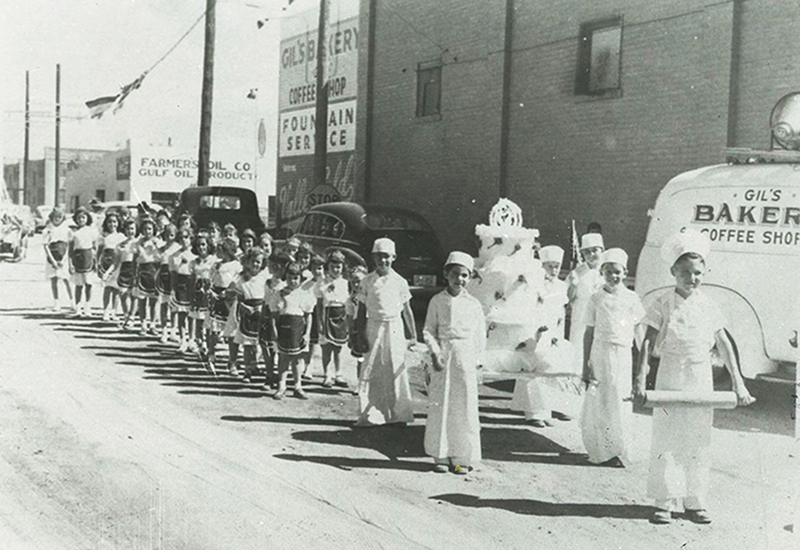
A group of children marching in a parade in Belen in 1950 representing Gil’s Bakery.
Of all his many organizations, Gil was most active as a member of the Belen Board of Education. On Oct. 4, 1954, Gil’s brother, Ralph, who had been elected to the board in 1949, fell ill and asked Gil to sit in for him at a board meeting. Gil obliged, served out Ralph’s term and ran successfully on his own in February 1955.
In the course of the next 30 years, Gil won five additional elections and attended more than 350 school board meetings, a record in Belen history. His long tenure put him among the top five school board members in years of continual service in the state. He was inducted into the New Mexico School Board Hall of Fame in 1993.
Gil was proud of improvements in the Belen public school system during his long tenure in office. Although a life-long Democrat, he strove to take politics out of the hiring of school personnel. Also, the number of schools in the district grew, with building projects or additions at the high school, the junior high, Central Elementary School, H.T. Jaramillo Elementary School, Rio Grande Elementary School, Dennis Chavez Elementary School and a new grade school in Jarales.
The elementary school in Jarales was Gil’s crowning achievement. He had continuously lobbied for a new school south of town near where he had grown up. The school was built and, in the most controversial vote of his school board career, Gil voted in favor of a motion to name the school after him.
Gil believed, “If something is going to be done for someone, it should be done while he’s still alive.” He nevertheless admitted that his vote was “one of the few things I’ve had bad feelings about. I’ll always call it the Jarales school.”
Magistrate judge
In 1968, New Mexico revamped its local judicial system, eliminating the office of justice of the peace in communities across the state. Many justices of the peace had deservedly earned bad reputations for charging excessive fines for traffic tickets and other minor offenses because their salaries were based on a percentage of the fines they collected.
Tired of this source of corruption, New Mexicans had voted to replace justices of the peace with magistrate judges, to be compensated with salaries and chosen in local elections.
Valencia County originally had three magistrate divisions. Recognizing an important new way to serve his community, Gil ran for and won election to the magistrate judgeship in division two, based in Belen.
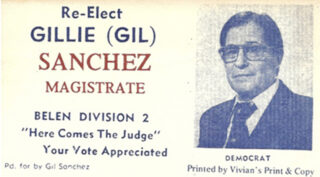
Gil always said that his toughest cases involved “family troubles,” especially when he saw the same couples and the same abuses over and over. Gil lectured abusive husbands and parents, hoping that he would help change their behavior.
In most disputes, Gil simply served as a mediator, winning the trust and admiration of nearly everyone who appeared in his court. Some of the most difficult cases were what Gil called the “your-dog-bit-my-dog” where there was no proof of what happened other than each side’s opinion.
Attorney Norm McDonald recalls one such case involving a goat and a chile patch. The owner of the chile patch complained that his neighbor’s goat had gotten into his chile and had eaten much of his crop. The goat’s owner denied the accusation and went so far as to load his goat onto his truck to bring it to Gil’s courtroom to prove the goat’s (and his) innocence.
After all, how could a goat have survived if it had eaten raw chile? No one recalls the outcome of this case, but it is definite that the goat never entered Gil’s courtroom, no less appear in his own defense.
In June 1971, Gil moved his courtroom to 233 N. Main St., directly south of his bakery. It was said that his was the only courtroom in the land with swinging doors leading from a bakery. Despite rumors that Gil appeared in court in an apron or with baking powder on his suit, he was always well dressed as a sign of respect for those who appeared before him. For years, Gil wore suits and his famous small bow ties or, later, his large ties, worn loosely at the neck.
Gil had definite opinions regarding proper proceedings and behavior in his courtroom. Everyone had to be appropriately dressed and respectful. He tolerated lawyers, although he considered some to be “necessary evils.” He always insisted that lawyers speak “plain English” rather than “legalese” that few people could understand and seldom helped achieve Gil’s main goal: an amicable conclusion of each case.
While most observers agreed that Gil was fair and just in his decisions, some believed that he was too lenient, especially with traffic tickets, often deferring the payment of fines or taking them “under advisement,” meaning they did not have to be paid.
His daughter, Gloria, who served as Gil’s clerk for more than 16 years, often felt this way, especially when the recipients of her father’s largess became ungrateful. Gloria remembers instances when Gil threw out six or seven tickets for a man, but when he made the culprit pay for just one, the man was so mad that he never spoke to the judge again.
Fortunately, dangerous incidents were rare. In one case, a woman accused of robbery became so incensed that she charged Gil as he sat at his bench. Gloria recalls that it took six men to control the defendant and restrain her in a straitjacket.
Attempted bribes were also rare. Gloria says that a man once placed something valuable (probably jewelry) in front of Gil in court. Interpreting the gesture to be a bribe, Gil told the man to get out. The accused claimed that he was only offering the judge a gift.
Gil’s most pleasant moments as a judge were when he officiated at weddings. Some weddings were held in his courtroom, but most took place in private homes.
Gil developed a set ceremony and “sermon” with the help of Fr. Gallegos; the text was typed both in English and in Spanish, depending on the engaged couple’s preference. Gil’s main problem with wedding ceremonies was when they took place in isolated parts of the county and he got lost, often arriving late and delaying the otherwise blissful event.
Gil won reelection as magistrate judge six times, always with the help of his family and friends who did everything from placing campaign signs along rural roads to going door-to-door to talk to voters.
Gloria remembers how popular her father was among most voters. Her only objection to campaigning was when she went to houses with fierce looking dogs. She simply refused to enter yards with overly aggressive animals on the premises.
Retirement
Gil shed his many hats gradually and, usually, willingly. He retired from the school board after 30 years of dedicated service. A grateful community bid him farewell at a dinner held in his honor at the Tierra del Sol Country Club in 1983.
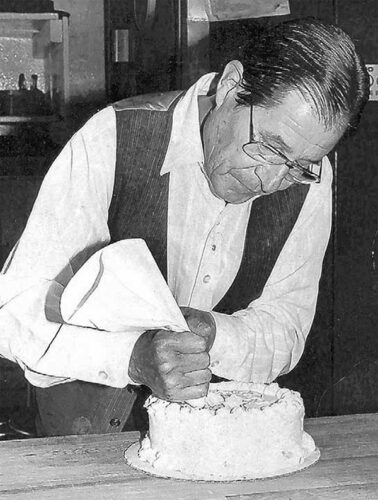
Gil and Priscilla closed their bakery on July 4, 1987. Thirty customers were already there by 8 a.m.; they had come to say good-bye and to eat their favorite doughnuts one last time.
Unfortunately, Gil was defeated when he ran for reelection to the bench in November 1994. Out of 15,000 votes cast, he lost by a mere 30. Perhaps it was inevitable that in the course of 26 years as a magistrate judge he would alienate at least some voters with his decisions.
Although described as “saddened” by the outcome, Gil was said to accept his loss with his usual grace and dignity. Five years later the new magistrate court building at 901 W. Castillo was named in his honor.
And then it was time to close his bakery. Gil had considered calling it quits as early as 1975 when the demands of serving as judge and running the bakery had become increasingly burdensome.
Gil and Priscilla had only taken one real vacation, a 10-day trip to Hawaii arranged by their son, Raymond. Otherwise, the most time they had taken off was on certain holidays (the Fourth of July was his favorite) and to go to the state fair, which Gil looked forward to each year. Maybe it was time to cut back. But the thought of not working at the bakery was worse than working there too much. In Gil’s words, the prospect gave him the “shivers.”
The decision to close the bakery was finally made in 1987, 40 years after its grand opening in 1947. There were several reasons for closing, including competition from supermarkets that Gil said were “taking over with package stuff.”
Gil remembered when Albuquerque had as many as 10 bakeries in the early 1970s, until they were forced to close, one by one, in the face of supermarket competition. The same had happened in Belen a decade later.
Gil also said that good workers were getting harder and harder to find. Employees simply lacked the work ethic and high standards Gil had learned from the German baker Harrell in the 1930s.
Reliable bakers were particularly difficult to hire and retain. When a baker called in sick or otherwise didn’t come to work, Gil had to jump out of bed and get to the bakery to do the work himself.
At 61, he was not as willing and not as able to work 12- to 14-hour days. Priscilla said after such long days, Gil usually came home so exhausted that he would sit down, soak his feet in Epson salt and quickly fall asleep.
And so Gil and Priscilla closed their bakery on July 4, 1987. Thirty customers were already there by 8 a.m.; they had come to say good-bye and to eat their favorite doughnuts one last time.
The place looked much the same as it had for years. Lime-colored stools still lined the long serving counter. Formica-top tables still stood down the center. A famous portrait photo of President Kennedy still hung on the wall beside drawings by Gil and Priscilla’s eight grandchildren and 10 great-grandchildren. Well-wishers dropped by all day.
The News-Bulletin sent a reporter to write a front-page article for the paper. Gil told the reporter that he was sure he’d miss the people, but probably not the work and long hours. There were lots of hugs and kisses, accolades and stories.
We can only imagine what went through Gil’s mind as he locked his store for the last time after more than 14,000 days in business, regardless of the season, regardless of the weather and regardless of his physical health.
Gil Sanchez died on July 1, 1999, almost exactly 11 years after that closing; he was 82. His loving wife and partner, Priscilla, died four years later, on Nov. 20, 2003.
A large part of the heart of Belen closed with Gil’s Bakery in 1987. Other restaurants have attempted to open in the old building, but none succeeded. Other restaurants in town have come and gone without ever equaling the popularity of the old bakery.
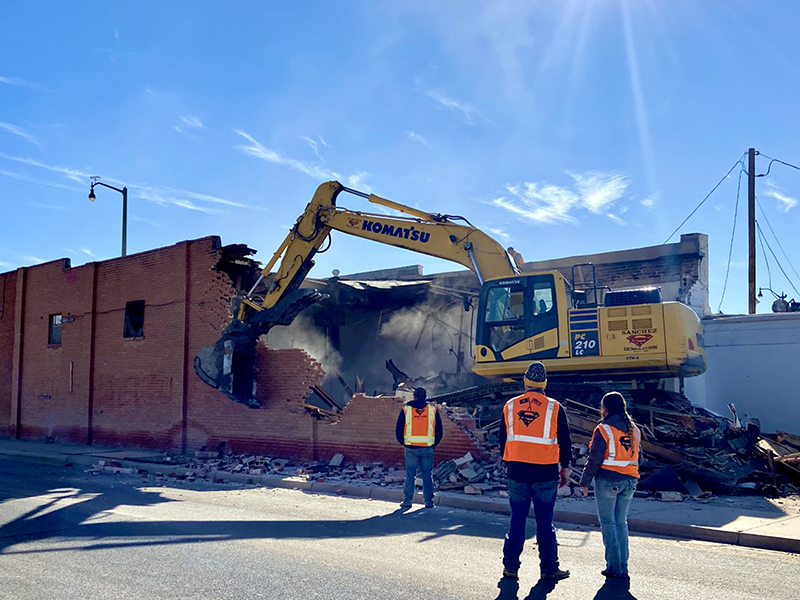
Brick by brick, the building at the corner of Main Street and Reinken Avenue came down on Thursday, Jan. 5. The structure had become structurally unsound after being hit multiple times by vehicles over the years. Sanchez Demolition was hired to demolish the building once occupied by Gil’s Bakery, a popular bakery and restaurant in Belen, which was opened by Gillie Sanchez and his wife, Priscilla, on Monday, April 14, 1947, and closed a little more than 40 years later on Saturday, July 4, 1987. (Clara Garcia | News-Bulletin photo)
After standing empty for many years, the building that Gil’s Bakery was housed in faced demolition on Jan. 5, 2023. Work started at 9 a.m. that morning. The physical building was gone by nightfall. Many dropped by to watch and pick up memory bricks. Thousands mourned its passing, vowing never to forget its part in their lives and in Belen history.

Richard Melzer, guest columnist
Richard Melzer, Ph.D., is a retired history professor who taught at The University of New Mexico–Valencia campus for more than 35 years. He has served on the board of directors of the Valencia County Historical Society for 30 years; he has served as the society’s president several times.
He has written many books and articles about New Mexico history, including many works on Valencia County, his favorite topic. His newest book, a biography of Casey Luna, was published in the spring of 2021.
Those interested in joining the Valencia County Historical Society should contact Dr. Melzer at [email protected].

